Presentations
Wild Potpurri | Reptiles & Amphibians | Birds | Mammals | Insects | Prices
 WILDLIFE
PRESENTATIONS are available to audiences of all ages and can be
tailored to any level. Emphasis is placed on Michigan’s living
resources to allow participants to become more familiar with wildlife
most likely encountered, and affected by our actions. Many feature live
specimens available to the audience for close inspection. Presentations
are available to cover an endless variety of wildlife topics. The list
below features general wildlife subjects, with suggested areas of
emphasis.
WILDLIFE
PRESENTATIONS are available to audiences of all ages and can be
tailored to any level. Emphasis is placed on Michigan’s living
resources to allow participants to become more familiar with wildlife
most likely encountered, and affected by our actions. Many feature live
specimens available to the audience for close inspection. Presentations
are available to cover an endless variety of wildlife topics. The list
below features general wildlife subjects, with suggested areas of
emphasis.
Contact Jim or Carol McGrath at Nature Discovery for pricing information at (517) 655-5349 or naturedisc87@gmail.com
Wild Potpurri
The list below is so broad that many patrons have a difficult time deciding. The potpourri format calls on Nature Discovery to choose which wildlife to present over the hour with your group. The time of year and location in which we are presenting are considered in our choice of topics. Since we are especially renowned for our live reptiles and amphibians, some of these are always incorporated into the potpourri. We’ll also commonly choose at least one insect or other invertebrate, one bird, one mammal or fish, and possibly a wild plant to highlight.
Reptiles and Amphibians
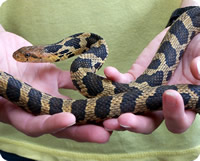 Michigan
is home to 17 species of snakes, 10 turtles, 13 frogs & toads, 10
salamanders and 2 lizards. Nature Discovery maintains live specimens of
most of these species for use in presentations and exhibits. These are
often supplemented with color slides, audio recordings and other props.
Presentation titles within this heading include:
Michigan
is home to 17 species of snakes, 10 turtles, 13 frogs & toads, 10
salamanders and 2 lizards. Nature Discovery maintains live specimens of
most of these species for use in presentations and exhibits. These are
often supplemented with color slides, audio recordings and other props.
Presentation titles within this heading include:
- R&A Sampler: You leave it to us to choose which reptile and amphibian species to highlight. The season and location of the presentation are considered in our choice of species.
- Michigan Snakes: Our most popular presentation.
Fears and misconceptions about snakes are addressed in addition to
dissemination of sound information about snake biology and ecology.
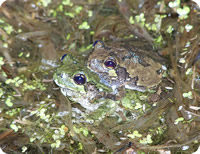 Individual
species' habits and characteristics are discussed with inspection of
live specimens. At presentation's end, all participants are encouraged
to handle the snakes. Some can also be fed in front of audience on
request.
Individual
species' habits and characteristics are discussed with inspection of
live specimens. At presentation's end, all participants are encouraged
to handle the snakes. Some can also be fed in front of audience on
request. - Michigan Turtles: Live specimens and slides are used to help participants understand the biology and ecology of each species. Factors contributing to population declines are also discussed, in addition to what we can do to help in their survival. At the presentation's conclusion, handling of some of the specimens is permitted.
- Michigan Frogs: Many of our
state's frog populations are in serious decline due to a variety of
factors. The Michigan DNR has instituted a volunteer-based
annual frog survey to help monitor the population trends around the
state. In order to participate, you must learn to identify each species
by song. With live specimens, color slides and audio recordings from
Nature
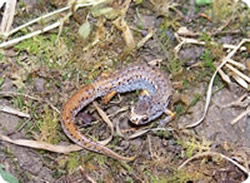 Discovery's
CD, Frogs of the Great Lakes Region, participants become familiar with
the breeding biology, range and habitat of each species.
Discovery's
CD, Frogs of the Great Lakes Region, participants become familiar with
the breeding biology, range and habitat of each species. - Michigan Amphibians: Includes most of the information contained in the frogs presentation but expands to include discussion of salamanders. Members of this amphibian order are believed to be undergoing the same declines as frog populations, but due to their secretive nature, they are much more difficult to observe. Live specimens and slides are presented.
Birds
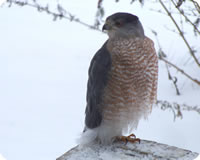 With over 300
species of breeding and migratory birds in the state, there is an
abundance of interesting biological and ecological aspects to explore.
Many topics are best suited to the season of the year in which the
presentation is given, while others are altered to emphasize the season
in which the presentation is given. All presentations involve color
slides and audio recordings. Below is a sampling of avian presentation
titles, but is by no means complete in its scope.
With over 300
species of breeding and migratory birds in the state, there is an
abundance of interesting biological and ecological aspects to explore.
Many topics are best suited to the season of the year in which the
presentation is given, while others are altered to emphasize the season
in which the presentation is given. All presentations involve color
slides and audio recordings. Below is a sampling of avian presentation
titles, but is by no means complete in its scope.
- Backyard Birds
- Feeding Birds
- Winter Birds
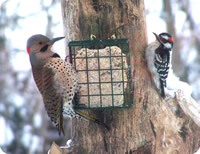 Migration
Migration- Migratory Songbirds
- Bird Nesting
- Cavity Nesters
- Bird Songs (Birding by Ear)
- Birds of Prey
- Owls, Hawks & Eagles
- Waterfowl
- Wetland Birds
- Woodpeckers
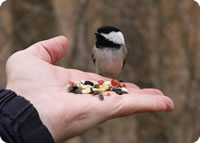 Insect-easters
Insect-easters- Swallows
- Blackbirds
- Cowbirds & Nest Parasitism
- Attracting Bluebirds
- Warblers & Vireos
- Native Sparrows
- Endangered & Extinct Michigan Birds
Mammals
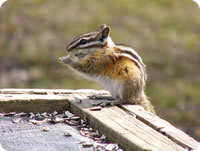 The
majority of Michigan’s 60 species of mammals are difficult to
observe in the wild due to shy or nocturnal habits and seasonal
limitations in activity. Color slides, skulls, and pelts are used to
give participants a more intimate look at their lives. On occasion,
some live small mammals are available for observation. A sample of
titles includes:
The
majority of Michigan’s 60 species of mammals are difficult to
observe in the wild due to shy or nocturnal habits and seasonal
limitations in activity. Color slides, skulls, and pelts are used to
give participants a more intimate look at their lives. On occasion,
some live small mammals are available for observation. A sample of
titles includes:
- Michigan Mammal Sampler
- Backyard Mammals
- Mammals in Winter
- Nocturnal Mammals
- Bats
 Squirrels
Squirrels- Rodents
- Weasel Family
- Carnivores
- Mice, Voles & Shrews
Insects
 The most
abundant and diverse class of life on earth allows for a huge variety
of topics to discuss. Here are a few popular topics in detail plus some
other titles.
The most
abundant and diverse class of life on earth allows for a huge variety
of topics to discuss. Here are a few popular topics in detail plus some
other titles.
- Michigan Butterflies: Learn about some common butterflies other than the well-known Monarch, including where and how to find them, what host plants their larvae eat, how they spend the winter, and other interesting aspects of their lives. Live and pinned specimens are available for close inspection in addition to color slides.
- Michigan Moths: There are ten times more moth species in the world than butterflies, which allows for more variation in physical traits and survival strategies than their more popular day-flying kin. Meet some of Michigan's most impressive and interesting, but widely unknown species through inspection of live specimens, pinned specimens and color slides.
- Michigan Butterflies & Moths: A
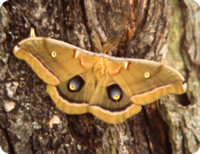 potpourri of information gleaned from the two presentations above.
potpourri of information gleaned from the two presentations above. - Finding & Rearing Giant Silk Moths:
Some of our continent's largest, most impressive moths can be found
right here in Michigan, yet many people can go years without
encountering one. Becoming privy to their life cycles and behaviors
greatly increases your changes of finding Cecropia, Polyphemus,
Promethea and Luna Moths in any metamorphic stage. Larvae then, become
easy to attain and successfully rear into adult moths. Color slides are
enchanced with live adult moths and/or newly
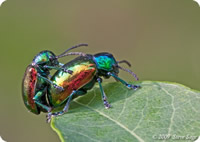 hatched
larvae (June),larger larvae (July-Aug), or cocoons (Sept-May). With
advance notice, newly hatched larvae (in June) can be distrubuted to
participants to take home.
hatched
larvae (June),larger larvae (July-Aug), or cocoons (Sept-May). With
advance notice, newly hatched larvae (in June) can be distrubuted to
participants to take home. - Insect Potpourri: A mix of insects with a seasonal slant. Live specimens and color slides accompany interesting information about their life histories, including metamorphosis and ecology.
- Other Topics:
- Insect Classification
- How to Pin and Mount Insects for Display
- The Hymenoptera (Bees, Wasps & Ants)
- The Largest Order of Life on Earth: Coleoptera (Beetles)
- The Diptera (True Flies)
- The Orthoptera (Grasshoppers & Crickets)
- The Odonata (Dragonflies & Damselflies)
- The True Bugs: Hemiptera & Homoptera
- Metamorphosis
- Insect Survival in Winter
To keep the presentation quality at its highest, we 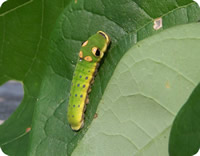 recommend
audience sizes of 50 or less. Higher rates than those listed below
apply to larger audiences and assemblies. Contact us for more
information. An additional .70/mi mileage fee applies to non-local
destinations.
recommend
audience sizes of 50 or less. Higher rates than those listed below
apply to larger audiences and assemblies. Contact us for more
information. An additional .70/mi mileage fee applies to non-local
destinations.
One-Hour Presentation: $200.
90-Min Presentation: $250.
Multiple presentations at the same location on the same day:
First hour $200/hr, then $100/hr.